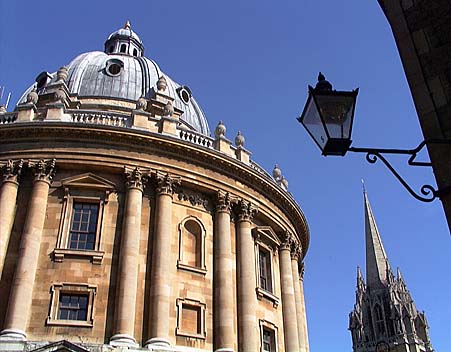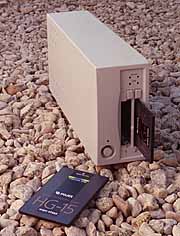Fuji goes Green!
by John Henshall

Fujix DS-515 digital camera kit.

Until recently, the field of portable 'instantaneous'
digital cameras belonged to just one manufacturer. But now all that has
changed, with two new cameras in a joint venture from Fuji (who supplied
the electronics) and Nikon (who built the special camera body and optics).
The Fujix DS-515, also available from Nikon as the E2S, can capture three
images per second, up to seven frames at a burst. The camera is also available
with less RAM - and consequently a slower capture rate of one image
per second and a lower price - as the Fujix DS-505 (Nikon E2).
Billed as the first digital camera to offer a full-frame viewfinder, this
camera uses a relay lens system to reduce the 24x36mm image produced by
the lens to the 6.6x8.8mm size of a tv format (two thirds of an inch) area
array CCD with 1280x1000 pixels. The camera body is consequently quite bulky,
so it would be wise to invest in a wide OpTech neck strap.
The aspect ratio is 1.28 to 1, instead of 35mm film's 1.5 to 1, so the horizontal
angle of view of lenses on the digital camera is 0.85 times the angle which
the same lens would give on a 35mm film camera. For example, a 28mm lens
on this camera would be equal to 33mm on an SLR using film. The viewfinder
is every bit as accurate as you would expect from Nikon.
The relay optics give the camera a high basic sensitivity (EI 800 - the equivalent of ISO800 using film) because the light is concentrated and therefore much brighter at the CCD, resulting in a higher effective exposure index. Unfortunately, this benefit is lost because the relay optics limit the light passed by all lenses to a widest aperture of 6.7. EI 800 at 6.7 is the equivalent of EI 100 at 2.4. Lens aperture is set by a thumb wheel on the front of the camera body. Changing stops on the lens has no effect on exposure. It all works well but it's a pity that the relay optics result in some confusion about stops. Because of the relay optics, depth of field is somewhat greater than you would imagine, though there is no depth of field preview.
Although the relay system does result in a full-frame viewfinder image,
it limits the Nikon lenses which can be used with the camera. Coverage was
fine on the supplied 35 - 70mm 2.8 zoom. I am a long-time Nikon user
and have a wide selection of older Nikkor lenses, such as the 15mm 3.5,
16mm 2.8 full-frame fisheye and 18mm 4. None of these will work with the
DS-515, nor will many of Nikon's current ultra-wideangles.
The camera's colorimetry is superb. The images look
stunning as soon as they are acquired into Photoshop, usually requiring
no colour adjustment at all. Balance to ambient light is selectable -
tungsten, fluorescent, sunny, cloudy or shade. Even mixed lighting sources
can be balanced - sensed by an opal diffuser on the front of the camera
body.


One 15Mb PCMCIA flash memory card can hold 5 interpolated
but uncompressed 'Hi' resolution 2.6MB images in TIFF format. Using on-board
JPEG compression, 21 'Fine' format 635KB images, 43 'Normal' format 332KB
images, or 84 'Basic' format 165KB images may be held on the same card -
or a mixture of all the various resolutions. The on-board JPEG compression
is excellent and only at the highest compression ratios are any artifacts
noticeable. Even then, they are unlikely to be obtrusive at normal image
magnifications. I used the 'Fine' format setting for all the shots reproduced
here but could probably have used the 'Normal' setting, to record twice
as many images on a single card, without any noticeable loss of quality.
I cannot over emphasise how impressive this is.

Raw images are processed and enhanced in the camera.
This results in pictures which immediately look sharp on-screen but which
will only take limited further sharpening. The quality is fine for a quarter
page or slightly larger in a high quality magazine, or at least 8x10 inches
in a newspaper. No colour ailiasing is evident in any of my images.

The separate PCMCIA card reader CR-500, although
a PC device, works extremely well with the Mac. Image processing takes place
in the camera, so files may be opened directly using applications such as
Photoshop, even without a special plug-in. However, a special Photoshop
plug-in is available and offers the additional advantage of being able to
display a page of thumbnails. Unfortunately, it only allows one image at
a time to be acquired. If you want to acquire a batch of images, note their
numbers using the plug-in thumbnails, then copy them all across directly
from the PCMCIA card. It's faster.


Metering in other digital cameras, which use CCDs occupying only a small
part of the viewfinder, can be somewhat variable. The Nikon metering system
in this full-frame-viewfinder special body works well.
One of the major facilities of the DS-515, which
other cameras do not have, is a video output socket. This allows the digital
images from the PCMCIA card to be viewed on a normal domestic television
set or - on location - using a small LCD portable. Televisions
are found everywhere and, in my opinion, the ability to view images quickly
and easily in this way - in colour on a large screen, without the need
for a computer - is a facility which all digital cameras should have.
The DS-515's colour output is truly international, being switchable between
PAL (Europe) and NTSC (Japan, USA etc). This video output may be connected
to a video printer, to produce colour proofs.


The cost of all this state-of-the-art portable digital
technology is around £11k for the DS-515 or £9k for the DS-505.


You will have noticed my general enthusiasm for this new camera. It's
good to have some healthy competition at last in this leading-edge field
of portable 'instantaneous' digital cameras. And it's good to see that Fuji
are now really going green.